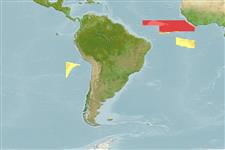>
Alepocephaliformes (Slickheads and tubeshoulders.) >
Alepocephalidae (Slickheads)
Etymology: Bathytroctes: Greek, bathys = deep + Greek, trokta, -on = sweets for dessert; also = troktos, -e, -on = edible (Ref. 45335).
Environment: milieu / climate zone / depth range / distribution range
Ökologie
seewasser bathypelagisch; tiefenbereich 0 - 2100 m (Ref. 4460). Deep-water; 8°N - 28°S, 86°W - 9°W (Ref. 57322)
Eastern Central Atlantic: Ascension Island. Indian Ocean: Mascareigne Plateau.
Size / Gewicht / Alter
Maturity: Lm ? range ? - ? cm
Max length : 32.3 cm SL Männchen/unbestimmt; (Ref. 4460)
Kurzbeschreibung
Bestimmungsschlüssel | Morphologie | Morphometrie
Wirbelzahl: 41 - 43. Large eyes, torpedo-like body, with flanks slightly concave. Length of snout less than the orbit's diameter. Anal opening connected to the anterior part of the anal fin. Maximum length is less than 17.5 cm (Ref. 34286).
Minimum depth from Ref. 58018.
Life cycle and mating behavior
Geschlechtsreife | Fortpflanzung | Ablaichen | Eier | Fecundity | Larven
Markle, D.F. and Y.I. Sazanov, 1990. Alepocephalidae. p. 246-264. In J.C. Quero, J.C. Hureau, C. Karrer, A. Post and L. Saldanha (eds.) Check-list of the fishes of the eastern tropical Atlantic (CLOFETA). JNICT, Lisbon; SEI, Paris; and UNESCO, Paris. Vol. 1. (Ref. 4460)
IUCN Rote Liste Status (Ref. 130435: Version 2024-2)
Bedrohung für Menschen
Harmless
Nutzung durch Menschen
Fischereien:
Tools
Zusatzinformationen
Download XML
Internet Quellen
Estimates based on models
Preferred temperature (Ref.
123201): 1.8 - 2.5, mean 2.3 °C (based on 604 cells).
Phylogenetic diversity index (Ref.
82804): PD
50 = 0.5005 [Uniqueness, from 0.5 = low to 2.0 = high].
Bayesian length-weight: a=0.00347 (0.00163 - 0.00737), b=3.19 (3.00 - 3.38), in cm total length, based on LWR estimates for this (Sub)family-body shape (Ref.
93245).
Trophic level (Ref.
69278): 3.5 ±0.5 se; based on size and trophs of closest relatives
Widerstandsfähigkeit (Ref.
120179): mittel, Verdopplung der Population dauert 1,4 - 4,4 Jahre. (Preliminary K or Fecundity.).
Fishing Vulnerability (Ref.
59153): Low to moderate vulnerability (29 of 100).
